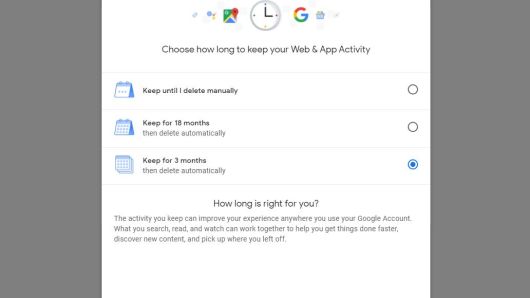Google confirms it will automatically delete users' data

Choose how long you want Google to keep your information before it's automatically deleted.
(Web Desk) – Google has begun rolling out a feature that allows you to configure how long it can save data from all of the Google services you use, like maps, search and everything you do online.
Until now, you had to manually delete this data or turn it off entirely. Deleting it means Google doesn’t always have enough information about you to make recommendations on what it thinks you’ll like, or where you might want to go.
Now, you can tell Google to automatically delete personal information after three months or 18 months. Here’s how you can do that.
- Visit myaccount.google.com and log in if you haven’t already.
- Choose "Data & Personalization" on the left-side panel.
- Select the arrow next to "Web and App Activity."
- Choose "Manage Activity."
- Select "Choose to delete automatically."
- Select either 18 months or three months.
Choose how long you want Google to keep your information before it’s automatically deleted.
If you select three months, it provides as little information as possible and it could be probably the best for privacy. But Google’s activity page says this: "The activity you keep can improve your experience anywhere you use your Google Account. What you search, read and watch can work together to help you get things done faster, discover new content and pick up where you left off."

Google said Tuesday it will expand these controls to make them easier to find inside of its apps. But for now, this is the quickest and easiest way to manage your privacy. Also, Google said it will roll out similar controls this week for how it tracks your location, so look for that soon.
Writing in the official Google safety and security blog, David Monsees and Marlo McGriff, the product managers for Google search and maps respectively, say that the company is responding to user feedback asking to make managing data privacy and security simpler.
"You can already use your Google Account to access simple on/off controls for Location History and Web & App Activity," they say, "and if you choose, to delete all or part of that data manually."
What’s new is the soon to be rolled out "auto-delete controls" that will enable users to set time limits on how long Google can save your data.
Set it and forget it: Rolling out soon to your Google Account, new auto-delete controls will make it even easier to manage your Location History and activity data → https://t.co/IkOP6srCjA pic.twitter.com/DIzQ4yJZrA
— Google (@Google) May 1, 2019
Said to be arriving within weeks, the new controls will apply to location history as well as web and app activity data to start with. Users will be able to choose a time limit of between three and 18 months after which the data concerned will automatically delete on a rolling basis.
You can already delete this data manually if you want, but the ability to have it deleted automatically is long overdue in my never humble opinion. Especially given reports last year that suggested Google was storing location data even when users had turned off location history and considering the somewhat arduous manual deletion process.
Not that everyone will want to delete this data of course. As with most things online these days it comes down to a choice between privacy and function. Actually, make that a balance between the two as it’s rare for anyone to be totally binary when it comes to such matters truth be told.
Google says that this data "can make Google products more useful for you, like recommending a restaurant that you might enjoy, or helping you pick up where you left off on a previous search."
If you are of the don’t store any of my location data thank you very much persuasion, then disabling location history altogether would seem like a better option given that some mobile apps can track location data when they aren’t running.
For everyone else, the new auto-deletion controls will be a welcome weapon in the "taking back control of at least some of your data" arsenal.
Keep checking the Data and Personalization section of your Google account settings, specifically the "Manage your activity controls" option I would imagine, to see if the function has rolled out for you in the coming weeks.

